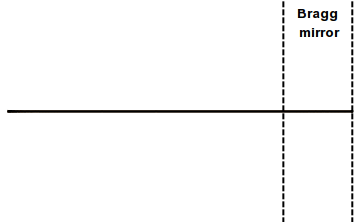Distributed Bragg Reflector on:
[Wikipedia]
[Google]
[Amazon]
 A distributed Bragg reflector (DBR) is a
A distributed Bragg reflector (DBR) is a
 A distributed Bragg reflector (DBR) is a
A distributed Bragg reflector (DBR) is a reflector
Reflector may refer to:
Science
* Reflector, a device that causes reflection (for example, a mirror or a retroreflector)
* Reflector (photography), used to control lighting contrast
* Reflecting telescope
* Reflector (antenna), the part of an ant ...
used in waveguides, such as optical fibers. It is a structure formed from multiple layers of alternating materials with varying refractive index, or by periodic variation of some characteristic (such as height) of a dielectric waveguide, resulting in periodic variation in the effective refractive index in the guide. Each layer boundary causes a partial reflection of an optical wave. For waves whose vacuum wavelength is close to four times the optical thickness of the layers, the many reflections combine with constructive interference, and the layers act as a high-quality reflector. The range of wavelengths that are reflected is called the photonic stopband
A stopband is a band of frequencies, between specified limits, through which a circuit, such as a filter or telephone circuit, does not allow signals to pass, or the attenuation is above the required stopband attenuation level. Depending on applic ...
. Within this range of wavelengths, light is "forbidden" to propagate in the structure.
Reflectivity
The DBR's reflectivity, , forintensity
Intensity may refer to:
In colloquial use
*Strength (disambiguation)
*Amplitude
* Level (disambiguation)
* Magnitude (disambiguation)
In physical sciences
Physics
*Intensity (physics), power per unit area (W/m2)
*Field strength of electric, ma ...
is approximately given by
:
where and are the respective refractive indices of the originating medium, the two alternating materials, and the terminating medium (i.e. backing or substrate); and is the number of repeated pairs of low/high refractive index material. This formula assumes the repeated pairs all have a quarter-wave thickness (that is , where is the refractive index of the layer, is the thickness of the layer, and is the wavelength of the light).
The frequency bandwidth of the photonic stopband can be calculated by
:
where is the central frequency of the band. This configuration gives the largest possible ratio that can be achieved with these two values of the refractive index.
Increasing the number of pairs in a DBR increases the mirror reflectivity and increasing the refractive index contrast between the materials in the Bragg pairs increases both the reflectivity and the bandwidth. A common choice of materials for the stack is titanium dioxide (''n'' ≈ 2.5) and silica (''n'' ≈ 1.5). Substituting into the formula above gives a bandwidth of about 200 nm for 630 nm light.
Distributed Bragg reflectors are critical components in vertical cavity surface emitting lasers and other types of narrow-linewidth laser diodes such as distributed feedback (DFB) lasers and distributed bragg reflector (DBR) lasers. They are also used to form the cavity resonator (or optical cavity An optical cavity, resonating cavity or optical resonator is an arrangement of mirrors or other optical elements that forms a cavity resonator for light waves. Optical cavities are a major component of lasers, surrounding the gain medium and provi ...
) in fiber laser
A fiber laser (or fibre laser in British English) is a laser in which the active gain medium is an optical fiber doped with rare-earth elements such as erbium, ytterbium, neodymium, dysprosium, praseodymium, thulium and holmium. They are related t ...
s and free electron lasers.
TE and TM mode reflectivity
This section discusses the interaction of transverse electric (TE) andtransverse magnetic
A transverse mode of electromagnetic radiation is a particular electromagnetic field pattern of the radiation in the plane perpendicular (i.e., transverse) to the radiation's propagation direction. Transverse modes occur in radio waves and microwav ...
(TM) polarized light with the DBR structure, over several
wavelengths and incidence angles. This reflectivity of the DBR structure (described below)
was calculated using the transfer-matrix method (TMM), where
the TE mode alone is highly reflected by this stack, while the TM modes are passed
through. This also shows the DBR acting as a polarizer
A polarizer or polariser is an optical filter that lets light waves of a specific polarization pass through while blocking light waves of other polarizations. It can filter a beam of light of undefined or mixed polarization into a beam of well ...
.
For TE and TM incidence we have the reflection spectra of a DBR stack, corresponding
to a 6 layer stack of dielectric contrast of 11.5, between an air and dielectric layers.
The thicknesses of the air and dielectric layers are 0.8 and 0.2 of the period, respectively.
The wavelength in the figures below, corresponds to multiples of the cell period.
This DBR is also a simple example of a 1D photonic crystal. It has a complete TE band gap, but only a pseudo TM band gap.
Bio-inspired Bragg Reflectors
Bio-inspired Bragg Reflectors are 1D photonic crystals inspired by nature. Reflection of light from such a nanostructured matter results in structural colouration. When designed from mesoporous metal-oxides or polymers, these devices can be used as low-cost vapor/solvents sensors. For example, colour of this porous multi-layered structures will change when the matter filling up the pores is substituted by another, e.g. substituting air with water.See also
* * * ** * * * * *References
{{Reflist Optical devices Fiber optics